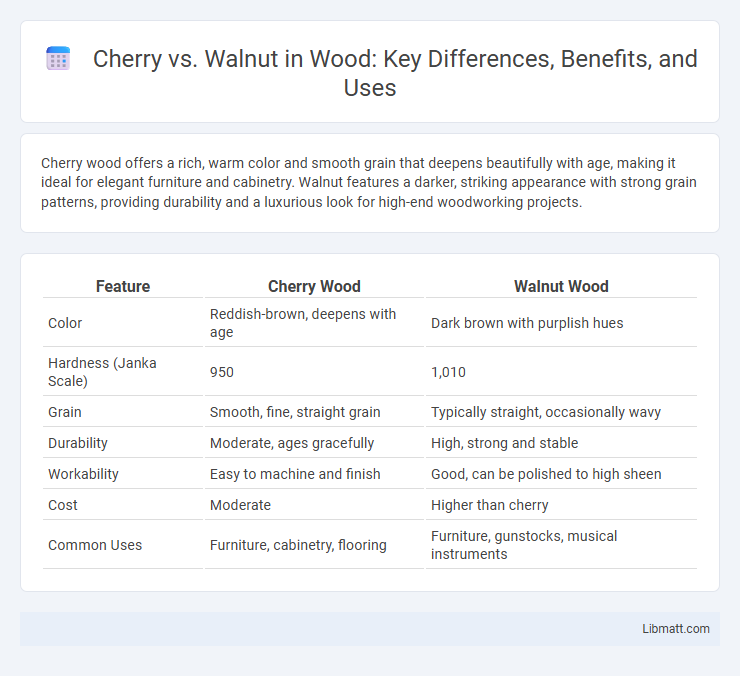Cherry wood offers a rich, warm color and smooth grain that deepens beautifully with age, making it ideal for elegant furniture and cabinetry. Walnut features a darker, striking appearance with strong grain patterns, providing durability and a luxurious look for high-end woodworking projects.
Table of Comparison
| Feature | Cherry Wood | Walnut Wood |
|---|---|---|
| Color | Reddish-brown, deepens with age | Dark brown with purplish hues |
| Hardness (Janka Scale) | 950 | 1,010 |
| Grain | Smooth, fine, straight grain | Typically straight, occasionally wavy |
| Durability | Moderate, ages gracefully | High, strong and stable |
| Workability | Easy to machine and finish | Good, can be polished to high sheen |
| Cost | Moderate | Higher than cherry |
| Common Uses | Furniture, cabinetry, flooring | Furniture, gunstocks, musical instruments |
Cherry vs Walnut: An Overview
Cherry wood features a rich, reddish-brown hue that darkens with age, prized for its smooth grain and warm tone, making it popular for fine furniture and cabinetry. Walnut wood offers a deep, chocolate-brown color with a straight grain pattern and high durability, favored for high-end woodwork and flooring. Both hardwoods balance aesthetics and strength, but walnut is generally harder and more resistant to wear than cherry.
Origin and Botanical Differences
Cherry wood originates primarily from the Prunus avium tree native to Europe and North America, while walnut comes from the Juglans genus, especially Juglans nigra, indigenous to North America. Botanically, cherry wood is identified by its fine, straight grain and reddish-brown hue that darkens with age, contrasting with walnut's coarser texture and rich, dark brown color with occasional purples and grays. Your choice between cherry and walnut will reflect a preference for their distinct visual and tactile characteristics rooted in separate botanical families.
Appearance: Grain, Color, and Texture
Cherry wood features a fine, straight grain with a smooth texture that darkens from light pinkish-brown to a rich reddish-brown over time. Walnut exhibits a more pronounced, wavy grain pattern with a deep chocolate to purplish-brown color and a slightly coarse texture. Your choice between cherry and walnut will influence the aesthetic warmth and character of the finished piece due to these distinct visual and tactile qualities.
Durability and Hardness Comparison
Cherry wood offers moderate durability with a Janka hardness rating of about 950, making it relatively soft and prone to dents and scratches compared to other hardwoods. Walnut is harder and more durable, boasting a Janka rating of approximately 1,010, providing better resistance to wear and impact in high-traffic areas. Choosing walnut for your furniture or flooring ensures improved longevity and strength while maintaining an elegant appearance.
Workability and Finishing Qualities
Cherry wood offers excellent workability due to its fine, straight grain and moderate hardness, making it easy to cut, shape, and sand for intricate woodworking projects. Walnut, while harder and denser, provides a smooth finish and holds details exceptionally well, though it may require sharper tools and slower feed rates to achieve optimal results. Both woods respond beautifully to stains and finishes, with cherry developing a rich, warm patina over time and walnut showcasing a deep, elegant sheen that highlights its natural grain patterns.
Cost and Availability
Cherry wood is generally more affordable and widely available compared to walnut, making it a popular choice for furniture and cabinetry. Walnut's higher cost stems from its limited supply, slower growth rate, and premium quality, often positioning it as a luxury material. Both woods are readily found in specialized lumber yards, but walnut's rarity can lead to longer procurement times and higher prices.
Best Uses for Cherry Wood
Cherry wood is prized for its rich color and smooth grain, making it ideal for fine furniture, cabinetry, and decorative veneers. Its workability and natural finish enhance detailed woodworking projects like turned items and intricate inlays. You'll find cherry wood excels in interior applications where warmth and elegance are desired, but it is less suitable for outdoor use due to its moderate durability.
Best Uses for Walnut Wood
Walnut wood is highly prized for its strength, durability, and rich color variations, making it ideal for high-end furniture, cabinetry, and flooring. Its fine, straight grain and natural resistance to decay also lend well to carving, gunstocks, and veneer applications. Walnut's dimensional stability and smooth finish are perfect for musical instruments and decorative woodturning projects.
Environmental Impact and Sustainability
Cherry wood has a moderate environmental impact due to its slower growth rate and selective harvesting methods, making sustainable sourcing essential to minimize deforestation. Walnut, typically grown in managed plantations, offers a more sustainable option due to faster growth cycles and higher yield per acre, which reduces pressure on natural forests. Your choice between cherry and walnut should consider the certification and origin to ensure environmental responsibility and long-term forest conservation.
How to Choose: Cherry or Walnut for Your Project
Choosing between cherry and walnut wood depends on color preference and project requirements; cherry offers a warm, reddish-brown hue that deepens with age, while walnut provides a rich, dark brown tone with a striking grain pattern. Consider durability and hardness; walnut is generally harder and more resistant to dents, making it suitable for high-traffic furniture, whereas cherry is easier to shape and works well for intricate details. Evaluate budget as walnut tends to be more expensive, and match the wood type to the style and longevity expectations of your woodworking project.
Cherry vs walnut Infographic

 libmatt.com
libmatt.com